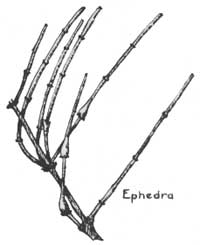|
ZION
Plants of Zion National Park |

|
Zion-Bryce Museum Bulletin
Number 1
PLANTS OF ZION NATIONAL PARK
Families of Plants
(continued)
PINE FAMILY (PINACEAE)
SINGLELEAF PINYON, Pinus monophylla. A scrubby, short-needle pine, needles borne singly, with small cones from which are obtained the pine nuts of commerce (also from the next species). It grows on the dry rocky talus slopes in the lower part of the Upper Sonoran Zone, prefering the warmer, dryer slopes. This nut pine is common in Nevada and eastern California, Zion Park being on the extreme eastern edge of its range.
PINYON PINE, Pinus edulis. Closely resembles the preceding species, but bears its needles in pairs, rather than singly. It is found everywhere in the Upper Sonoran Zone in Zion, except in the lower and warmer exposures, usually associated with Utah juniper. Together with the singleleaf pinyon, it forms the bulk of the so-called "pygmy forest" that sparsely clothes practically all the slopes in the park below 7000 feet (to 7400 on warm slopes), covering 30% of the entire park area. It is more valued for pine nuts than is the singleleaf pinyon.
WESTERN YELLOW PINE, Pinus ponderosa. The largest tree in the park, easily recognized by its tall reddish-yellow trunk and long needles borne in bundles of three. It forms an open forest over much of the park above 7000 feet, and individual trees or small groves are widely scattered down to 5100 feet, or even lower in such cool retreats as Upper Emerald Pool. It is the dominant species in about 32% of the park area, but in only a few places, as Horse Pasture Plateau, does it form pure stands such as are seen in the Kaibab Forest.

DOUGLAS FIR, Pseudotauga taxifolia. This moisture-loving tree, which attains gigantic size in the northwest, grows in all of the cool, shady canyons in Zion Park, and on north exposures above 6500 feet where moisture is sufficient, but it is poorly adapted to this region and does not grow to a large size, nor form extensive pure stands. It is not a true fir; its scientific name describes it exactly: "false hemlock with yew-like leaves".
WHITE FIR, Abies concolor. This true fir is found in much the same climatic conditions as the douglas fir, but does not require quite so much moisture. However, there is only one place in the park, Refrigerator Canyon, where it is the dominant species; elsewhere it occurs as scattered individuals among yellow pines or douglas firs.
In Zion Park there are two kinds of JUNIPERS, or cedars as they are popularly known. (Plate II) RED CEDAR, Juniperus scopulorum, is a Transition and Canadian Zone tree with beautiful red aromatic heartwood, so nearly like that of the eastern red cedar that only an expert can distinguish the lumber from the two species. The picture frames in Bryce Museum are of local red cedar. This tree usually grows above 5000 feet, but is not especially common outside the pygmy forest belt, where it occupies the higher cooler slopes along with Pinus edulis. It is found sparingly down to 4500 feet in cool canyons, as Emerald Pools, and is scattered generally over all the high plateaus. Its large berries end compact bark distinguish it from the UTAH JUNIPER, Juniperus utahensis, which has small berries and loose, shreddy bark. This tree is confined to the Upper Sonoran Zone, where it occurs almost everywhere but in the river bottoms. It is most plentiful in the lower part of the zone (4000 to 5500 feet), associated with single leaf pinyon to form the lower part of the pygmy forest.
JOINTFIR FAMILY (GNETACEAE)

This family is here represented by odd, almost leafless shrubs distantly related to the pines. They have green stems, and very small leaves, and are able to withstand great drought. A drug, ephedrine, is obtained from some Chinese species, but not from the two that are native here. However, a pleasant bitter tea is often brewed from the stems, which contain tannin. The species in Zion are: Ephedra viridis and Ephedra nevadensis. Both are known as Brigham or Mormon Tea. They both occur throughout the Upper Sonoran Zone, the latter being rare at low elevations.
CATTAIL FAMILY (TYPHACEAE)
Nearly everyone is familiar with the COMMON CATTAIL, Typha latifolia, tall rush-like plants bearing long brown seed spikes. They are the principal marsh plants of this region, filling many of the marshes with their rank growth. Small patches grow along the Virgin River, Shunes Creek, and the Parunuweap. The NARROW LEAF CATTAIL, Typha angustifolia, is also reported from here.